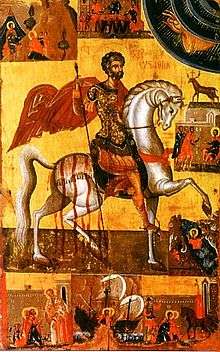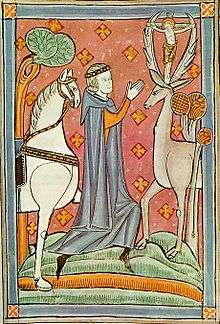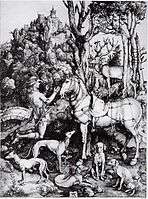Saint Eustace
Saint Eustace, also known as Eustachius or Eustathius in Latin,[1] is revered as a Christian martyr. His hagiographical text Legend of St. Eustace was popular throughout Christendom of the Middle Ages, especially in the thirteenth and fourteenth centuries of France and was written in different languages such as Latin, Greek, French, English, and Anglo-Saxon. Major events occurring in the text were also popular amongst different forms art such as sculptures illuminate manuscripts, stained glass, enamel, ivory, and murals.[2] Legend places him in the 2nd century AD. A martyr of that name is venerated as a saint in the Anglican Church.[3] He is commemorated by the Catholic Church and the Orthodox Church on September 20. The Armenian Apostolic Church commemorates St. Eustace on October 1.[4]
Saint Eustace and companions | |
|---|---|
 Greek Orthodox icon of St. Eustathios | |
| Martyrs | |
| Died | 118 AD |
| Venerated in | Anglican Church; Roman Catholic Church; Eastern Orthodox Church; Oriental Orthodoxy |
| Feast | September 20 (Western Christianity, Byzantine Christianity) Thout 22 (Coptic Christianity) |
| Attributes | Christian Martyrdom, bull; crucifix; horn; stag; oven |
| Patronage | against fire; difficult situations; fire prevention; firefighters; hunters; hunting; huntsmen; Madrid; torture victims; trappers |
Legend of St. Eustace
Placidus's conversion
In the 13th century French tradition of the narrative, it begins with Placidus (Eustace's name before he was baptized) hunting, and while hunting, he follows into woods a deer which causes Placidus to separate from a group of hunters; And while he followed, the deer reversed towards him. Placidus is then awestruck by a vision where he sees the cross between the antlers of the deer, and in that moment, Placidus is commanded by the voice of God to be baptized along with his family on that very night by the bishop of Rome; He is baptized and has his name changed to Eustace, and then he receives another vision from a voice informing him of upcoming trials for he and his family where they will suffer; They lose their goods, servants, livestock, and social status. They attempted to travel by boat, however, Eustace couldn't afford the voyage. Eustace and his two sons Agapius and Theopistus were then removed from the boat and separated from Eustace's wife Theopista, so Eustace and his sons continued traveling; They arrived at a river where Eustace had to carry them across one at a time. After successfully taking one to the other-side, Eustace attempted for the other, however, both of his sons where taken by animals while he was crossing the river; one by lion and the other by wolf. Unknowingly to Eustace, his sons were saved and raised independently.[2]
Fifteen years later
In the French tradition, Eustace then worked for fifteen years as a guard protecting fields until he was approached by two envoys of Roman emperor Trajan who were sent to persuade him to return to Rome and repel an uprising; Eustace complied. There in Rome, he was reinstated his original rank of general, led an army, and coincidentally, achieved victory in the home country of the captain who abducted his wife Theopista. Trading life stories after the battle, two soldiers discover they were the brothers abducted by animals, and overhearing them, Theopista recognizes her husband Eustace. Eustace and his family then return to Rome to celebrate at a victory dinner under the new Roman emperor Hadrian who was less tolerant towards Christians. Following the dinner, Hadrian requested Eustace and his family to make an offering to pagan gods; They refused. Eustace and his family were then thrown in a den of lions, but the lions did not touch them. Eustace and his family were then put into a brazen bull; They died but their bodies were untouched by the flames.[5]
Variants
The opening part of this tradition, up to St. Eustace's martyrdom, is a variant of a popular tale in chivalric romance: "the Man Tried By Fate".[6] Except for an exemplum in Gesta Romanorum,[7] all such tales are highly developed romances, such as Sir Isumbras.[8] A distant Indian origin for elements in the Eustace legend has been proposed.[9]
Diffusion of his veneration

The veneration of Eustace originated in the Eastern Orthodox Church wherein he is venerated as Saint Eustathios the Great Martyr (Greek: Ἅγιος Εὐστάθιος ὁ Μεγαλομάρτυς). N. Thierry postulated that the tradition may have originated in Cappadocia, pointing out that a large repertoire of images of the Vision of Eustace exist as frescoes in this region's early-Christian rock-cut churches. Thierry also notes a 7th-century Armeno-Georgian stele at the Davit Garedja monastery in present-day Georgia with a relief depicting the Vision of Eustace, and a relief on the chancel of Tsebelda in Abkhazia, dated variously from the 7th to the 9th century, that also depicts the Vision.[10]
In Armenia, Erewmanavank ("Convent of the Holy Apparition") near Egin was said to be built on the actual location of the encounter of Placidus with the deer. The earliest surviving text detailing this is a manuscript from 1446, but the monastery is far older than that and probably a Byzantine foundation; J.-M. Thierry considers it to be a 10th-century foundation, perhaps by Greeks from Cappadocia. Although the monastery was destroyed during the Armenian Genocide, Thierry, in the 1980s, noted that a transmitted form of the legend still existed among local Muslim Kurds who talked of a "deer of light" appearing at the site.[11]
In the West, an early-medieval church dedicated to him that existed in Rome is mentioned in a letter of Pope Gregory II (731–741).[12] His iconography may have passed to the 12th-century West, before which time European examples are scarce, in psalters, where the vision of Eustace, kneeling before a stag, illustrated Psalm 96, ii-12: "Light is risen to the just..."[13]
An early European depiction of Eustace, the earliest one noted in the Duchy of Burgundy, is carved on a Romanesque capital at Vézelay Abbey.[14] Abbot Suger mentions the first relics of Eustace in Europe, at an altar in the royal Basilica of St Denis;[15] Philip Augustus of France rededicated the church of Saint Agnès, Paris, which became Saint-Eustache (rebuilt in the 16th–17th centuries). The story of Eustace was popularized in Jacobus da Varagine's Golden Legend (c. 1260). Scenes from the story, especially of Eustace kneeling before the stag, then became popular subjects of medieval religious art: examples include a wall painting at Canterbury Cathedral and stained glass windows at the Cathedral of Chartres.
Saint Eustace's feast day in the Roman Catholic Church, as is also in the Eastern Orthodox Church, is September 20, as indicated in the Roman Martyrology.[16] The celebration of Saint Eustace and his companions was included in the Roman Calendar from the twelfth century until 1969, when it was removed because of the completely fabulous character of the saint's Acta,[16][17] resulting in a lack of sure knowledge about them. However, his feast is still observed by Roman Catholics who follow the pre-1970 Roman Calendar.
Saint Eustace's commemoration was removed from the General Roman Calendar in 1970, though he continued to be commemorated in the latest edition of the Roman Martyrology.[16] Local observance is still practiced.[18]
In culture
In medieval times, Saint Eustace's story was adapted into at least 10 different plays in varying forms.[19][20]
Eustace became known as a patron saint of hunters and firefighters, and also of anyone facing adversity; he was traditionally included among the Fourteen Holy Helpers.[21] He is one of the patron saints of Madrid, Spain. The island of Sint Eustatius in the Caribbean Netherlands is named after him.
The novels "The Herb of Grace" (US title: Pilgrim's Inn) (1948) by British author Elizabeth Goudge, and Riddley Walker (1980) by American author Russell Hoban, incorporate the legend into their plot. It has also inspired the film Imagination.
Saint Eustace is honored in County Kildare, Ireland. There is a church dedicated to him on the campus of Newbridge College in Newbridge, County Kildare, and the schools' logo and motto is influenced by the vision of Saint Eustace; a nearby village is named Ballymore Eustace.
Also St Eustachius church is situated in Pakiapuram villiage, Kanyakumari district, Tamil Nadu, India.
Sant'Eustachio is also honoured in Tocco da Casauria, a town in the Province of Pescara in the Abruzzo region of central Italy. The town's church, built in the twelfth century, was dedicated to Saint Eustace. It was rebuilt after being partially destroyed by an earthquake in 1706.[22]
The German alcoholic digestif Jägermeister has a round logo of a shining cross between the antlers of a stag, referring to two saints who had seen such a vision, Hubertus and Eustace.[23][24]
In Georgian mythology, Saint Eustace became associated with the hunting deity Apsat, patron of game animals.[25]
See also
- Historia Eustachio Mariana
- Hubertus, another saint with a similar legend
- Saint-Eustache, Paris, a Parisian church bearing his name
- Saint-Eustache, Quebec
- Sint Eustatius, a Caribbean Netherlands island named after Saint Eustace
References
- "Given name Eustace". Behind the Name. Retrieved October 29, 2015.
English form of EUSTACHIUS or EUSTATHIUS, two names of Greek origin which have been conflated in the post-classical period.
- Hourihane 2002, p. 60.
- We find on the authority of Mr. Parker in his work entitled the Calendar of the Anglican Church, and also in a work called Emblems of Saints, that St. Eustace was also sometimes represented carrying a horn (1878). The Archaeological journal. Longman, Brown, Green, and Longman. p. 281.CS1 maint: multiple names: authors list (link)
- https://www.panorama.am/en/news/2019/10/01/Armenian-Church/2174403
- Hourihane 2002, p. 60 & 61.
- Laura A. Hibbard, Medieval Romance in England p5 (New York: Burt Franklin) 1963
- Wikisource text of the Gesta Romanorum story.
- Hibbard, p.3.
- Engels, O., "Die hagiographischen texte der Papst Gelasius II' in der Überlieferung der Eustachius-, Erasmus- und Hypolistuslegende", Historisches Jahrbuch 76 (1956, noted by Ambrose 2006.
- Thierry, N. "Le culte du cerf en Anatolie et la Vision de saint Eustathe" in" Monuments et mémoires de la Fondation Eugène Piot" 1991, pp. 33–100.
- THIERRY, M., "Deux couvents gréco-arméniens sur l'Euphrate taurique", Byzantion, 61 (1991): 499–506.
- Krautheimer, R., Corpus basilicarum christianarum Romae (1940) vol. I:216f and Krautheimer, Rome: Profile of a City 1980:80f, 252, 271.
- Kirk Thomas Ambrose, The Nave Sculpture of Vézelay: The Art of Monastic Viewing (Pontifical Institute of Mediaeval Studies) 2006:45 gives examples.
- Ambrose 2006:45.
- The Eustace venerated at Saint-Denis may have been Eustace of Luxeuil, the second abbot of Luxueil, from 611.
- "Martyrologium Romanum" (Libreria Editrice Vaticana, 2001 ISBN 88-209-7210-7)
- "Calendarium Romanum" (Libreria Editrice Vaticana), p. 139
- "Roman Martyrology September, in English".
- Muir, Lynette (July 5, 2007). Love and Conflict in Medieval Drama: The Plays and Their Legacy. Cambridge University Press. p. 14. ISBN 978-0-521-82756-0.
- Lynette Muir (2007). Love and Conflict in Medieval Drama: The Plays and Their Legacy. Cambridge University Press. p. 14. ISBN 978-0-521-82756-0.
- Newton, William. "St. Eustace", Victoria and Albert Museum
- http://www.toccodacasauria.com/products/piazza-e-chiesa-di-sant-eustachio/
- McLean, Ian (November 19, 2014). Double Desire: Transculturation and Indigenous Contemporary Art. Cambridge Scholars Publishing. ISBN 9781443871334.
- Artforum International. Artforum International Magazine. 1999.
The Jägermeister logo, a stag with a cross between its horns, is the symbol of St. Hubert, the patron saint of dogs and hunters. According to the legend, while hunting in the forest Hubert encountered a stag with a glowing crucifix hovering between...
- Tuite, Kevin (2015). The institutional and vernacular cults of the military saints in the western Caucasus: Image-mediated diffusion and body shift in the cult of St Eustace in the western Caucasus (PDF). "On the Road to Paradise: Peripheral Visions, Unorthodox Iconographies," Canadian Anthropological Society. p. 4.
Sources
- Hibbard, Laura A., Medieval Romance in England, New York, Burt Franklin, 1963
- Hourihane, Colum (2002). Insights and Interpretations: Studies in Celebration of the Eighty-fifth Anniversary of the Index of Christian Art. Princeton University Press. ISBN 9780691099910.
Gallery
 Saint Eustace, from a 13th-century English manuscript.
Saint Eustace, from a 13th-century English manuscript. On a wing of the Paumgartner altarpiece, Albrecht Dürer painted Lukas Paumgartner with the banner of his patron, St. Eustace, in the contemporary armor of a Landsknecht.
On a wing of the Paumgartner altarpiece, Albrecht Dürer painted Lukas Paumgartner with the banner of his patron, St. Eustace, in the contemporary armor of a Landsknecht. Saint Eustachius, an engraving by Albrecht Dürer, ca. 1501. As in the Pisanello above, he kneels before a stag with a cross in its antlers, surrounded by dogs, including greyhounds.
Saint Eustachius, an engraving by Albrecht Dürer, ca. 1501. As in the Pisanello above, he kneels before a stag with a cross in its antlers, surrounded by dogs, including greyhounds. Saint Eustace icon, an example of the Cretan School.
Saint Eustace icon, an example of the Cretan School. Francesco Ferdinandi, The Martyrdom of St. Eustace. Located behind the main altar at the Church of Sant'Eustachio, Rome, this painting follows the narrative in the Golden Legend: For refusing to sacrifice to the gods, St. Eustace and his wife and sons are to be enclosed in a Brazen bull which will be heated until they die.
Francesco Ferdinandi, The Martyrdom of St. Eustace. Located behind the main altar at the Church of Sant'Eustachio, Rome, this painting follows the narrative in the Golden Legend: For refusing to sacrifice to the gods, St. Eustace and his wife and sons are to be enclosed in a Brazen bull which will be heated until they die. The stag-and-cross symbol of St. Eustace sits atop his church in Rome.
The stag-and-cross symbol of St. Eustace sits atop his church in Rome. The stag-and-cross symbol of St. Eustace as appearing on a bottle of Jägermeister digestif.
The stag-and-cross symbol of St. Eustace as appearing on a bottle of Jägermeister digestif. The Hunting Gonfalon, 18th C., Ukraine
The Hunting Gonfalon, 18th C., Ukraine
External links
| Wikimedia Commons has media related to Saint Eustace. |
- Patron Saints: Saint Eustachius
- Here Followeth the Life of St. Eustace in Caxton's translation of the Golden Legend
- Saint Eustace at the Christian Iconography web site

- The 'Life of St Eustace' window at Chartres Cathedral